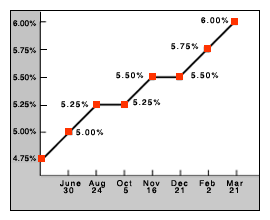|
You got your wish, Alan
|
 |
April 4, 2000: 4:38 p.m. ET
The Fed wanted to rein in the wealth effect; it may have succeeded
By Staff Writer M. Corey Goldman
|
NEW YORK (CNNfn) - If Federal Reserve Chairman Alan Greenspan intended to diminish exuberance in the high-flying stock market, and slow the torrid pace of the U.S. economy, well: Mission accomplished.
The Nasdaq composite index, the darling of the "new economy," went on a wild ride Tuesday, plunging more than 13 percent at one point before almost recovering. The Dow Jones industrial average plunged more 4 percent before doing the same thing, while the S&P 500 index plunged almost 5 percent.
For months, Greenspan has been subtly hinting that the wealth effect -- where surging equity prices have bolstered Americans' confidence about their economic situations -- was threatening to derail the record U.S. economic expansion. The wealthier consumers feel, his argument went, the more they will spend, the faster the economy will grow and the higher prices will rise.
In fact, to slow the economy and reign in the stock market, Greenspan and his colleagues at the Fed had been raising interest rates -- a move meant to boost borrowing costs and make consumers and businesses more leery about spending money. The Fed would never admit it was trying to rein in the stock market, but analysts agree that heady stock values have more than likely factored into the Fed's thinking in recent months.
Hello, Mercedes? Cancel my order
As of Tuesday, the stock market may no longer be the problem -- at least in terms of excess values prompting folks to run out and buy sport-utility vehicles (SUVs). Now, the whip-lashed market could potentially become a lead weight around the U.S. economy's ankle -- something that could force Greenspan and company to think twice about raising rates even more, according to analysts.
 "The retrenchment in equities will undoubtedly affect the economy later in the year," said William Sullivan, chief economist at Morgan Stanley Dean Witter. "This is not just a correction, it's an economic event that could affect consumer confidence and consumer spending down the road, leading to a more pronounced slowdown than the Fed is currently factoring in." "The retrenchment in equities will undoubtedly affect the economy later in the year," said William Sullivan, chief economist at Morgan Stanley Dean Witter. "This is not just a correction, it's an economic event that could affect consumer confidence and consumer spending down the road, leading to a more pronounced slowdown than the Fed is currently factoring in."
What has been plaguing Greenspan and most of his colleagues at the Fed for the better part of a year is the torrid pace of the U.S. economy and the possibility of accelerating inflation -- something that was feared would bring the record expansion of the U.S. economy to an abrupt halt.
To avoid that, the Fed began to slowly raise the one tool it has to control the pace of the economy -- the fed funds rate -- the target interest rate that commercial banks are required to stick to when lending to each other overnight. The rate dictates how much consumers and business pay in interest for their lines of credit, credit cards and other loans. It last raised the rate to 6 percent on March 21.
From an economic point of view, raising rates so far hasn't really worked. The U.S. economy expanded at a whopping 7.3 percent pace in the fourth quarter, almost double what the Fed and most economists deem to be a comfortable, non-inflationary pace of growth. And most analysts are predicting first-quarter growth to ring in above 5 percent.
More bad news?
"Underlying demand in the U.S. economy remains solid, irrespective of the stock market," said Michael Gregory, a vice president and senior economist with Lehman Brothers. "We are looking at growth in domestic spending that will probably exceed what we had in the fourth quarter."
That is, unless the stock market continues its downward trajectory, Gregory said.
In October 1987, when U.S. stock markets hit the skids, the Nasdaq posted a one-week drop of more than 17 percent -- a move that prompted the Fed to quickly begin lowering short-term rates. It lowered the fed funds rate to an average 6.58 percent by February 1998 from an average 7.29 percent.
Since touching an all-time high of 5048.63 on March 10, the Nasdaq has fallen almost 18 percent; it's still off a little more than 10 percent since last Friday. The average technology fund is down 17.95 percent for the week ending April 3, according to mutual fund tracker Morningstar.
 Economics 101 aside, watching one's 401(k) or mutual fund holdings dissipate can have a sobering effect on one's spending habits. From a consumer point of view, it makes people think twice about buying -- particularly without the psychological comfort that their portfolios are appreciating at a double- or triple-digit clip. Economics 101 aside, watching one's 401(k) or mutual fund holdings dissipate can have a sobering effect on one's spending habits. From a consumer point of view, it makes people think twice about buying -- particularly without the psychological comfort that their portfolios are appreciating at a double- or triple-digit clip.
From a business perspective, watching the market capitalization of one's company shrink faster than an ice cube in Jamaica can rapidly affect everything from hiring intentions to employee bonuses to purchasing capital goods to the way additional capital is raised for future projects.
Even with Tuesday's white-knuckle plunge, few analysts predict that the Fed will hold off raising rates again at its May 16 policy meeting. What the roller- coaster day did was wipe out any thought on Wall Street of a "between-meeting" rate increase by the Fed, which seemed possible, or a half-percent rate hike either in May or at the June 22 meeting.
They'll probably raise rates...
"I think the Fed is still on track to raise rates until the growth rate slows or until we see negative numbers on inflation," said Robert Heller, executive vice president of Fair Isaac, a San Francisco-based technology credit advisement company and a former Fed governor. "Only if we had a real stock market rout would they say, 'OK, time to hold your powder right now.'"
Here's why. The Fed recently has been focus on two main things within the U.S. economy -- the wealth effect, which has been driven by consumer spending and inflation, which has been driven in large part by rising oil prices.
 One thing almost all analysts and economists agree on is that the economy is firing on all cylinders and isn't slowing down. Another thing almost all of them agree on is that inflation is not a threat. On the contrary, falling oil prices and an expected slowdown in the U.S. economy could prompt what's known as disinflation -- where prices actually fall because of excess supply. One thing almost all analysts and economists agree on is that the economy is firing on all cylinders and isn't slowing down. Another thing almost all of them agree on is that inflation is not a threat. On the contrary, falling oil prices and an expected slowdown in the U.S. economy could prompt what's known as disinflation -- where prices actually fall because of excess supply.
If the stock market continues along its downward spiral -- if the losses that stocks have endured in recent weeks and months become permanent -- then the Fed may consider holding off taking further action beyond its May policy meeting, said Rob Palombi, a markets analyst with Standard & Poor's MMS.
"The pullback in stocks probably won't be enough to prevent the Fed from raising rates in May, but it should be enough to limit it to a quarter point, and force them to reassess how many more they may implement beyond," he said. "No matter what, the stock market's performance is going to have an impact on how consumers feel about spending money."
But maybe they'll think twice...
Joe Battipaglia, a stock market strategist with Gruntal & Co., agreed. "If the Fed's concern has been about the overall level of stock prices, and it has also been about the multiplier effect of wealth creation, then clearly having a correction like this may well lend itself to their deliberations of what they will do next," he said. "At the end of the day, they may well bring in that quarter of a point, but even that's in jeopardy now."
The bond market also seems to agree. The implied yield on the May fed funds futures contract, which indicates where investors expect the fed funds rate to be at the next Fed meeting, currently rests at 6.11 percent, indicating the market is factoring in a less than 25-percent chance the Fed will move.
Another factor -- one that has yet to be tallied on Wall Street, is the amount of margin calls investors are facing as a result of the market's steep declines.
 U.S. margin requirements, by law, dictate that investors can leverage themselves up to 50 percent of the value of their portfolios. In other words, an investor with $50,000 in stock could potentially borrow another $25,000 to purchase additional securities. Also by law, an individual who buys or sells a security has three business days to pay for it -- whether it's by using cash already in the account or paying back amounts borrowed on margin. U.S. margin requirements, by law, dictate that investors can leverage themselves up to 50 percent of the value of their portfolios. In other words, an investor with $50,000 in stock could potentially borrow another $25,000 to purchase additional securities. Also by law, an individual who buys or sells a security has three business days to pay for it -- whether it's by using cash already in the account or paying back amounts borrowed on margin.
As stocks fall in value, as they have in recent days, the amount an investor can be extended on margin shrinks, eventually prompting the financial institution that investor is dealing with to call in the margin. That involves either depositing cash to keep the margin under 50 percent of the value of the holdings or selling off some of the holdings at current market value.
That is definitely something that could play a significant role in the Fed's thinking, according to Morgan Stanley's Sullivan.
"There are a lot of people who are tremendously overextended and we're now getting down to a level to where these margin calls are massive," he said. "If we see some credit stress that comes out of this evisceration of market capitalization, if investors and even portfolio managers are forced to liquidate to pay for margin calls, then that could really sway the Fed's thinking." 
|
|
|
|
|
 |

|

